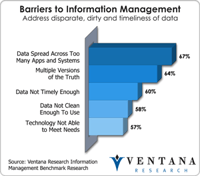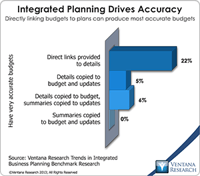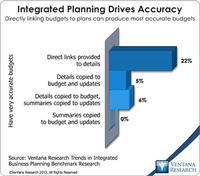Read More
Topics:
Office of Finance,
Operational Performance Management (OPM),
eDiscovery,
Exterro,
Data Governance,
Data Management,
Governance, Risk & Compliance (GRC),
Informatica,
Business Performance Management (BPM),
compliance,
Data,
Financial Performance Management (FPM),
Information,
Information Applications (IA),
Information Management (IM),
Risk,
Sales Performance Management (SPM),
Workforce Performance Management (WPM)
Tidemark announced the release of the Fall 2013 version of its eponymous cloud-based application that my colleague assessed earlier in 2013. This new release adds capabilities for labor planning and expense management as well profitability modeling and analysis. These two areas of planning and analysis are common to all businesses. The new release adds features that enhance the software’s ability to do sales forecasting, initiative planning and IT department planning. The company continues to...
Read More
Topics:
Big Data,
Performance Management,
Planning,
Predictive Analytics,
Office of Finance,
Operational Performance Management (OPM),
Reporting,
Budgeting,
Controller,
Analytics,
Cloud Computing,
In-memory,
Business Performance Management (BPM),
CFO,
Customer Performance Management (CPM),
Financial Performance Management (FPM),
Sales Performance Management (SPM),
Supply Chain Performance Management (SCPM),
Tidemark,
Workforce Performance Management (WPM),
Financial Performance Management,
financial reporting,
FPM,
Integrated Business Planning
Business planning is a new software category. These applications enable senior executives to integrate all the plans of business units into a single, integrated view, which helps them have more accurate plans, do more insightful what-if planning, achieve greater agility in reacting to changing business and economic conditions, and execute plans in a more coordinated fashion than was possible. Business planning software is intended for CEOs and COOs, who are not well served by current...
Read More
Topics:
Big Data,
Performance Management,
Planning,
Predictive Analytics,
Office of Finance,
Operational Performance Management (OPM),
Reporting,
Budgeting,
Controller,
Business Analytics,
Business Collaboration,
Cloud Computing,
In-memory,
Business Performance Management (BPM),
CFO,
Workforce Performance Management (WPM),
Financial Performance Management,
financial reporting,
FPM,
Integrated Business Planning
Oracle continues to enrich the capabilities of its Hyperion suite of applications that support the finance function, but I wonder if that will be enough to sustain its market share and new generation of expectations. At the recent Oracle OpenWorld these new features were on display, and spokespeople described how the company will be transitioning its software to cloud deployment. Our 2013 Financial Performance Management Value (FPM) Index rates Oracle Hyperion a Warm vendor in my analysis,...
Read More
Topics:
Big Data,
Mobile,
Planning,
Social Media,
ERP,
Human Capital Management,
Modeling,
Office of Finance,
Reporting,
Budgeting,
close,
closing,
Consolidation,
Controller,
driver-based,
Finance Financial Applications Financial Close,
Hyperion,
IFRS,
Tax,
XBRL,
Analytics,
Business Analytics,
Business Intelligence,
CIO,
Cloud Computing,
In-memory,
Oracle,
Business Performance Management (BPM),
CFO,
compliance,
Data,
Financial Performance Management (FPM),
benchmark,
Financial Performance Management,
financial reporting,
FPM,
GAAP,
Integrated Business Planning,
Price Optimization,
Profitability,
SEC Software
Business planning as practiced today is a relic, a process hemmed in by obsolete conceptions of what it should be. I use the term “business planning” to encompass all of the forward-looking activities in which companies routinely engage, including, for example, sales, production and head-count planning as well as budgeting. Companies need to take a fresh view of all these, adopting a new approach to business planning that while preserving continuity makes a substantial departure from what most...
Read More
Topics:
Big Data,
Planning,
Predictive Analytics,
Social Media,
Office of Finance,
Operational Performance Management (OPM),
Reporting,
Budgeting,
Controller,
In-memory,
Business Performance Management (BPM),
CFO,
Financial Performance Management (FPM),
Supply Chain Performance Management (SCPM),
Financial Performance Management,
financial reporting,
FPM,
Integrated Business Planning
We recently issued our 2013 Value Index on Financial Performance Management. Ventana Research defines financial performance management (FPM) as the process of addressing the often overlapping people, process, information and technology issues that affect how well finance organizations operate and support the activities of the rest of their organization. FPM deals with the full cycle of finance department activities, which includes planning and budgeting, analysis, assessment and review, closing...
Read More
Topics:
Mobile,
Planning,
Predictive Analytics,
Office of Finance,
Budgeting,
closing,
Consolidation,
contingency planning,
Analytics,
Business Analytics,
Business Collaboration,
Cloud Computing,
Business Performance Management (BPM),
CFO,
Financial Performance Management (FPM),
Value Index,
Financial Performance Management

















